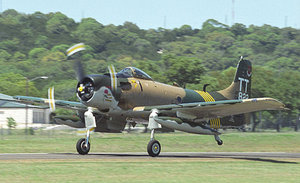A-1 Skyraider
|
|
The Douglas AD (later A-1) Skyraider was a US single-seat attack bomber of the 1950s, 1960s and early 1970s, a propeller-driven anachronism in the jet age with a remarkably long and successful career.
The Skyraider was originally designed in the 1940s by Ed Heinemann of the Douglas Aircraft Company, as a simpler alternative to the XBTD-1. At the time of the first prototype's flight on 18 March 1945, it was the largest production single-seater aircraft. The low-wing monoplane design started with a Wright R-3350 radial engine, later upgraded multiple times. Its distinctive feature was the presence of seven hardpoints on each wing, enabling it to carry a tremendous amount of ordnance for its size.
Although the Skyraider came into production too late for World War II, it turned out to be of great value in both the Korean and Vietnam Wars, since its weapon load and 10-hour flying time far surpassed the jets that were available.
It went through seven versions, starting with the AD-1, then AD-2 and AD-3 with various minor improvements, then the AD-4 with a more powerful R-3350-26WA engine. The AD-5 was significantly widened, allowing two crew to sit side-by-side (this was not the first multiple-crew variant, the AD-1Q being a two-seater and the AD-3N a three-seater); it also came in a 4-seat night-attack version, the AD-5N. The AD-6 was an improved AD-4B with improved low-level bombing equipment, and the final production version AD-7 was upgraded to a R-3350-26WB engine.
Production ended in 1957 with a total of 3,180 built. However, in 1962 the existing Skyraiders were redesignated A-1D through A-1J and later used by both the USAF and the Navy in the Vietnam War.
In addition to serving during Korea and Vietnam as an attack aircraft, it was modified into the first airborne early warning aircraft to see service off aircraft carriers. It served in this function in the USN and Royal Navy, being replaced by the E-1 Tracer and Fairey Gannet respectively in those services.
| Contents |
Variants
- AD-1 (statistics in table)
- AD-1Q - AD-1 with countermeasures
- AD-1U - AD-1 with radar countermeasures and tow target equipment, no armament and no water injection equipment
- XAD-1W - airborne early warning equipment, AD-3W prototype
- AD-2 - powered by 2,700 hp (2,000 kW) Wright R-3350-26W engine
- AD-2N - equipped for night attack
- AD-2Q - AD-2 with countermeasures
- AD-2U - AD-2 with radar countermeasures and tow target equipment, no armament and no water injection equipment
- AD-2W - airborne early warning equipment
- XAD-2 - similar to XBT2D-1 except engine, increased fuel capacity
- AD-3 - stronger fuselage, improved landing gear, new canopy design
- AD-3N - equipped for night attack
- AD-3Q - countermeasures equipment relocated for better crew comfort and improved
- AD-3W - airborne early warning equipment
- XAD-3E - AD-3W modified for ASW with Aeroproducts propellor
- AD-4 - strengthened landing gear, improved radar, G-2 compass, anti-G suit provisions, four 20 mm cannon and 14 Aero rocket launchers capable of carrying up to 50 lb (23 kg) of bombs
- AD-4L - equipped for winterization
- AD-4N - night attack and radar countermeasures
- AD-4Q - AD-4 with countermeasures
- AD-4W - airborne early warning equipment
- AD-5 (A-1E) - side by side seating for co-pilot, dive brake
- AD-5N (A-1G) - night attack version with radar countermeasures
- AD-5W (A-1E) - airborne early warning version
- AD-6 (A-1H) - three dive brakes, centerline station stressed for 3,500 lb (1,600 kg) of ordnance 30 inches (760 mm) in diameter, combination 14/30 inch (360/760 mm) bomb ejector and low/high altitude bomb director
- AD-7 (A-1J) - R3350-26WB engine, structural improvements to increase wing fatigue life
Units using the A-1
USAF Squadrons
- 1st Air Commando Squadron, Composite (later 1st Air Commando, Fighter; and 1st Special Operations Squadron)
- 6th Special Operations Squadron
- 22nd Special Operations Squadron
- 602nd Air Commando Squadron (later 602nd Fighter Squadron (Commando); and 602nd Special Operations Squadron)
- 4407th Combat Crew Training Squadron
USN Squadrons
- VA-1L
- VFAW-4
- VAW-11
- VAW-12
- VAW-13
- VAW-15
- VA-15
- VA-16
- VA-24
- VA-25
- VAQ-33
- VA-34
- VAW-35
- VA-35
- VA-42
- VA-45
- VA-52
- VA-54
- VA-55
- VA-64
- VA-65
- VA-74
- VA-75
- VA-92
- VA-94
- VA-95
- VA-104
- VA-105
- VA-114
- VA-115
- VA-122
- VA-125
- VA-126
- VA-135
- VA-144
- VA-145
- VA-152
- VA-154
- VA-155
- VA-165
- VA-174
- VA-175
- VA-176
- VA-194
- VA-195
- VA-196
- VA-215
- VA-215
USMC Squadrons
- VMC-1 (later VMCJ-1)
- VMC-2 (later VMCJ-2)
- VMC-3 (later VMCJ-3)
- VMAT-10
- VMAT-20
- VMA-121
- VMA-151
- VMA-211
- VMA-212
- VMA-225
- VMA-251
- VMA-324
- VMA-331
- VMA-332
Fleet Air Arm
- No. 849 NAS
Armée de l'Air
- Escadron 2/20 Ouarsenis
- Escadron 1/20 Aures-Nementchas
- Escadron 3/20 Oranie
- Escadron d'Appui Aerien 1/21
- Escadron de Marche 2/21
- Escadrille Legere d'Appui Aerien 1/22 Ain
Republic of Vietnam Air Force
- 514th Fighter Squadron (formerly 1st Fighter Squadron)
- 516th Fighter Squadron (formerly 2nd Fighter Squadron)
- 518th Fighter Squadron
- 520th Fighter Squadron
- 522nd Fighter Squadron
- 524th Fighter Squadron
- 530th Fighter Squadron
External link
| Related content | |
|---|---|
| Related Development | |
| Similar Aircraft | |
| Designation Series | |
| Related Lists | |
|
Lists of Aircraft | Aircraft manufacturers | Aircraft engines | Aircraft engine manufacturers Airports | Airlines | Air forces | Aircraft weapons | Missiles | Timeline of aviation |

